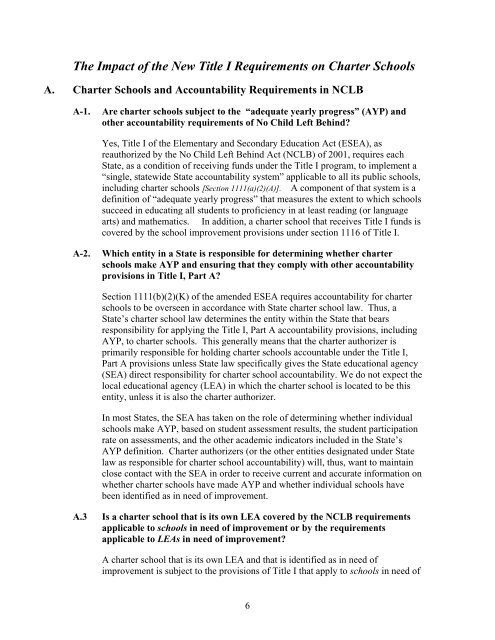The 21st Century Charter Schools Initiative
The 21st Century Charter Schools Initiative
The 21st Century Charter Schools Initiative
Create successful ePaper yourself
Turn your PDF publications into a flip-book with our unique Google optimized e-Paper software.
<strong>The</strong> Impact of the New Title I Requirements on <strong>Charter</strong> <strong>Schools</strong><br />
A. <strong>Charter</strong> <strong>Schools</strong> and Accountability Requirements in NCLB<br />
A-1.<br />
Are charter schools subject to the “adequate yearly progress” (AYP) and<br />
other accountability requirements of No Child Left Behind?<br />
Yes, Title I of the Elementary and Secondary Education Act (ESEA), as<br />
reauthorized by the No Child Left Behind Act (NCLB) of 2001, requires each<br />
State, as a condition of receiving funds under the Title I program, to implement a<br />
“single, statewide State accountability system” applicable to all its public schools,<br />
including charter schools [Section 1111(a)(2)(A)]. A component of that system is a<br />
definition of “adequate yearly progress” that measures the extent to which schools<br />
succeed in educating all students to proficiency in at least reading (or language<br />
arts) and mathematics. In addition, a charter school that receives Title I funds is<br />
covered by the school improvement provisions under section 1116 of Title I.<br />
A-2.<br />
Which entity in a State is responsible for determining whether charter<br />
schools make AYP and ensuring that they comply with other accountability<br />
provisions in Title I, Part A?<br />
Section 1111(b)(2)(K) of the amended ESEA requires accountability for charter<br />
schools to be overseen in accordance with State charter school law. Thus, a<br />
State’s charter school law determines the entity within the State that bears<br />
responsibility for applying the Title I, Part A accountability provisions, including<br />
AYP, to charter schools. This generally means that the charter authorizer is<br />
primarily responsible for holding charter schools accountable under the Title I,<br />
Part A provisions unless State law specifically gives the State educational agency<br />
(SEA) direct responsibility for charter school accountability. We do not expect the<br />
local educational agency (LEA) in which the charter school is located to be this<br />
entity, unless it is also the charter authorizer.<br />
In most States, the SEA has taken on the role of determining whether individual<br />
schools make AYP, based on student assessment results, the student participation<br />
rate on assessments, and the other academic indicators included in the State’s<br />
AYP definition. <strong>Charter</strong> authorizers (or the other entities designated under State<br />
law as responsible for charter school accountability) will, thus, want to maintain<br />
close contact with the SEA in order to receive current and accurate information on<br />
whether charter schools have made AYP and whether individual schools have<br />
been identified as in need of improvement.<br />
A.3 Is a charter school that is its own LEA covered by the NCLB requirements<br />
applicable to schools in need of improvement or by the requirements<br />
applicable to LEAs in need of improvement?<br />
A charter school that is its own LEA and that is identified as in need of<br />
improvement is subject to the provisions of Title I that apply to schools in need of<br />
6

















